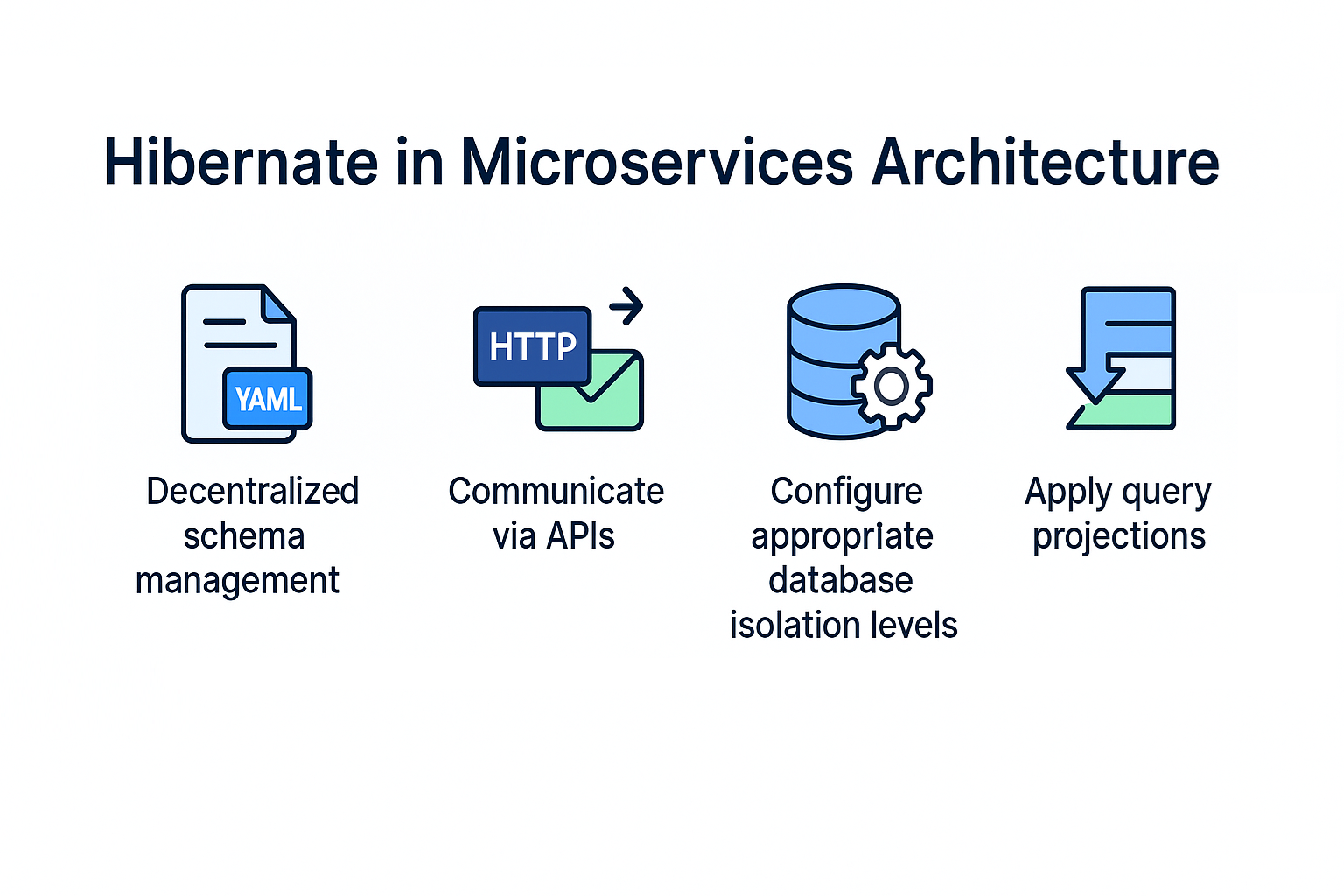Microservices have become the de facto architecture for building scalable and independent services. Each microservice manages its own data and business logic. Hibernate, as a powerful ORM framework, plays a crucial role in simplifying persistence logic by mapping Java objects to relational tables.
In a microservices architecture, Hibernate helps developers achieve data isolation, scalability, and maintainability. This tutorial covers how to integrate Hibernate effectively in microservices, best practices for persistence, performance optimizations, and pitfalls to avoid.
Hibernate in Microservices: The Core Idea
In a monolithic application, one Hibernate SessionFactory often manages the persistence layer across the entire system. In microservices, each service should have its own Hibernate configuration and its own database (or schema) to ensure data isolation.
Key Principles:
- Database-per-service: Each microservice owns its database.
- Decentralized schema management: Use tools like Flyway or Liquibase.
- No cross-service joins: Communicate via REST, gRPC, or messaging systems.
- Independent Hibernate mappings: Each service defines only its required entities.
Analogy: Imagine multiple restaurants. Each has its own kitchen (database), chefs (Hibernate configurations), and menu (entities). They don’t share kitchens, but they can exchange dishes (data) through delivery (APIs).
Setting Up Hibernate in a Microservice
Maven Dependency
<dependency>
<groupId>org.springframework.boot</groupId>
<artifactId>spring-boot-starter-data-jpa</artifactId>
</dependency>
<dependency>
<groupId>org.postgresql</groupId>
<artifactId>postgresql</artifactId>
<scope>runtime</scope>
</dependency>
application.properties
spring.datasource.url=jdbc:postgresql://localhost:5432/orders_db
spring.datasource.username=orders_user
spring.datasource.password=secret
spring.jpa.hibernate.ddl-auto=validate
spring.jpa.show-sql=true
spring.jpa.properties.hibernate.format_sql=true
Entity and Mapping Example
@Entity
@Table(name = "orders")
public class Order {
@Id
@GeneratedValue(strategy = GenerationType.IDENTITY)
private Long id;
private String customerName;
@OneToMany(mappedBy = "order", cascade = CascadeType.ALL, fetch = FetchType.LAZY)
private List<OrderItem> items = new ArrayList<>();
}
@Entity
@Table(name = "order_items")
public class OrderItem {
@Id
@GeneratedValue(strategy = GenerationType.IDENTITY)
private Long id;
private String productName;
private Double price;
@ManyToOne(fetch = FetchType.LAZY)
@JoinColumn(name = "order_id")
private Order order;
}
✅ Best Practice: Always use lazy fetching in microservices to avoid unnecessary data loading.
CRUD Operations in a Microservice
Create Order
Session session = sessionFactory.openSession();
Transaction tx = session.beginTransaction();
Order order = new Order();
order.setCustomerName("Alice");
OrderItem item = new OrderItem();
item.setProductName("Laptop");
item.setPrice(1200.0);
item.setOrder(order);
order.getItems().add(item);
session.save(order);
tx.commit();
session.close();
Read Order
Order order = session.get(Order.class, 1L);
System.out.println(order.getCustomerName());
Update Order
session.beginTransaction();
Order order = session.get(Order.class, 1L);
order.setCustomerName("Updated Name");
session.update(order);
session.getTransaction().commit();
Delete Order
session.beginTransaction();
Order order = session.get(Order.class, 1L);
session.delete(order);
session.getTransaction().commit();
Querying in Microservices
HQL Example
List<Order> orders = session.createQuery("FROM Order o WHERE o.customerName = :name", Order.class)
.setParameter("name", "Alice")
.list();
Criteria API Example
CriteriaBuilder cb = session.getCriteriaBuilder();
CriteriaQuery<Order> cq = cb.createQuery(Order.class);
Root<Order> root = cq.from(Order.class);
cq.select(root).where(cb.equal(root.get("customerName"), "Alice"));
List<Order> results = session.createQuery(cq).getResultList();
Caching in Microservices
- First-Level Cache (per session) – always enabled.
- Second-Level Cache (per service) – configure per microservice.
- Query Cache – avoid for volatile, transactional services.
✅ Best Practice: Use READ_ONLY cache strategy for reference data and READ_WRITE for rarely updated data.
Performance Considerations
- Use DTO projections instead of fetching entire entities.
- Apply batch fetching to reduce N+1 select problems.
- Optimize with indexes at the database level.
- Use connection pooling (e.g., HikariCP).
spring.datasource.hikari.maximum-pool-size=20
spring.jpa.properties.hibernate.jdbc.batch_size=50
Real-World Spring Boot Integration
@Repository
public interface OrderRepository extends JpaRepository<Order, Long> {
List<Order> findByCustomerName(String customerName);
}
Spring Boot simplifies Hibernate integration with Spring Data JPA.
Common Pitfalls in Microservices with Hibernate
- Cross-service joins – Breaks service independence.
- Overusing eager fetching – Leads to performance bottlenecks.
- Improper caching – Risk of stale data across services.
- Schema coupling – Avoid shared schemas between services.
Best Practices for Hibernate in Microservices
- Use database-per-service architecture.
- Apply optimistic locking with
@Versionto handle concurrency. - Monitor queries using tools like p6spy or Hibernate Statistics.
- Keep entities simple; use DTOs for inter-service communication.
- Combine Hibernate with Spring Cloud or Kafka for distributed transactions.
📌 Hibernate Version Notes
Hibernate 5.x
- Based on
javax.persistence. - Legacy Criteria API still used.
- Requires more manual configuration.
Hibernate 6.x
- Migrated to Jakarta Persistence (
jakarta.persistence). - Improved SQL support for microservices.
- Streamlined bootstrapping and query APIs.
Conclusion and Key Takeaways
Hibernate is a powerful ORM that fits well in microservices architecture when used with the right design patterns. By keeping databases independent, optimizing caching, and applying best practices, you can ensure scalable and resilient services.
Key Takeaway: In microservices, Hibernate should focus on service autonomy, efficient persistence, and lightweight integration with Spring Boot and other frameworks.
FAQ: Expert-Level Questions
1. What’s the difference between Hibernate and JPA?
Hibernate is an ORM framework that implements JPA with extra features.
2. How does Hibernate caching improve performance?
It reduces database load by storing frequently accessed data in memory.
3. What are the drawbacks of eager fetching?
It loads too much data upfront, causing slow performance.
4. How do I solve the N+1 select problem in Hibernate?
Use JOIN FETCH, batch fetching, or entity graphs.
5. Can I use Hibernate without Spring?
Yes, but Spring Boot simplifies setup and transaction handling.
6. What’s the best strategy for inheritance mapping?SINGLE_TABLE for performance, JOINED for normalized schemas.
7. How does Hibernate handle composite keys?
By using @EmbeddedId or @IdClass.
8. How is Hibernate 6 different from Hibernate 5?
Hibernate 6 uses Jakarta Persistence, modern APIs, and better SQL compliance.
9. Is Hibernate suitable for microservices?
Yes, if each service owns its database and Hibernate is configured per service.
10. When should I not use Hibernate?
When working with schema-less databases or requiring raw SQL performance.
